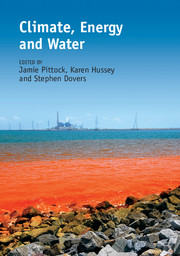Book contents
- Frontmatter
- Contents
- List of contributors
- Acknowledgements
- 1 Justifying, extending and applying “nexus” thinking in the quest for sustainable development
- 2 Water resources, climate change and energy
- 3 Implications of climate change for energy systems in a multisectoral context
- 4 Fossil fuels and water: A complex and evolving relationship
- 5 Renewable energy and water
- 6 Hydropower within the climate, energy and water nexus
- 7 Water and biofuels
- 8 Trade-offs and synergies between water and energy use in rural Australia
- 9 Management of the urban energy-water nexus
- 10 Managing the electricity-water nexus in China, France, India and the United States
- 11 Cross-sectoral governance of the climate, energy and water sectors: A ‘Rubik's cube’ analysis of cross-sectoral co-ordination
- 12 Regulation of the nexus
- 13 Climate, energy and water: the potential roles and limitations of markets
- 14 Strategies to mainstream climate change, energy, water and food security nexus knowledge and skills
- 15 A nexus of nexuses: systemic governance for climate response
- 16 Integrated modelling of the energy-water nexus in the American West
- 17 Biodiversity and the climate, energy and water nexus
- 18 Consumers, food supply chain and the nexus
- 19 Future prospects in climate, energy and water research and policy
- Index
6 - Hydropower within the climate, energy and water nexus
Published online by Cambridge University Press: 05 April 2015
- Frontmatter
- Contents
- List of contributors
- Acknowledgements
- 1 Justifying, extending and applying “nexus” thinking in the quest for sustainable development
- 2 Water resources, climate change and energy
- 3 Implications of climate change for energy systems in a multisectoral context
- 4 Fossil fuels and water: A complex and evolving relationship
- 5 Renewable energy and water
- 6 Hydropower within the climate, energy and water nexus
- 7 Water and biofuels
- 8 Trade-offs and synergies between water and energy use in rural Australia
- 9 Management of the urban energy-water nexus
- 10 Managing the electricity-water nexus in China, France, India and the United States
- 11 Cross-sectoral governance of the climate, energy and water sectors: A ‘Rubik's cube’ analysis of cross-sectoral co-ordination
- 12 Regulation of the nexus
- 13 Climate, energy and water: the potential roles and limitations of markets
- 14 Strategies to mainstream climate change, energy, water and food security nexus knowledge and skills
- 15 A nexus of nexuses: systemic governance for climate response
- 16 Integrated modelling of the energy-water nexus in the American West
- 17 Biodiversity and the climate, energy and water nexus
- 18 Consumers, food supply chain and the nexus
- 19 Future prospects in climate, energy and water research and policy
- Index
Summary
Introduction
Ensuring secure supplies of energy and water are among the great challenges that society confronts while seeking to maintain robust economies and raise billions of people out of poverty. The energy and water challenges are not independent, and the linkages between them are increasingly recognized. For example, the extraction and generation of energy can require enormous amounts of water while, similarly, the treatment and distribution of water can require considerable amounts of energy (Hussey and Pittock 2012; van Vliet et al. 2012). In the United States, the energy sector is the largest user (though not consumer) of water, while in California, for example, distributing water consumes nearly 20 per cent of the state's energy usage (California Energy Commission 2005).
Beyond these direct linkages – generating energy requires water, providing water requires energy – energy and water are intertwined in a variety of other ways. Hydropower is a form of energy where water itself acts as the ‘fuel’ for generation. Because nearly all hydropower is generated from dams on rivers, hydropower provides a very specific example of how water and energy interact. First, hydropower is a user of water that interacts with other users, such as urban water supply and irrigation. Second, the infrastructure required to generate hydropower – namely, dams and diversions – changes how rivers function. By altering river function, hydropower can affect a broad array of other resources, benefits and values produced by rivers. Third, other activities within a watershed can alter hydrologic processes, such as erosion, which can influence the performance and longevity of hydropower infrastructure (eg through reservoir sedimentation).
Climate is a third key factor, expanding the interaction between energy and water into a trio: the energy-water-climate nexus. Climate change will affect the water-energy nexus in a variety of ways. Most simply, climate change is forecast to alter both the supply and demand for water and energy (Kundzewicz et al. 2008; Ebinger and Vergara 2011), adding greater complexity and uncertainty to an already complex interaction and potentially adding increased stressors.
- Type
- Chapter
- Information
- Climate, Energy and Water , pp. 79 - 107Publisher: Cambridge University PressPrint publication year: 2015
- 3
- Cited by



